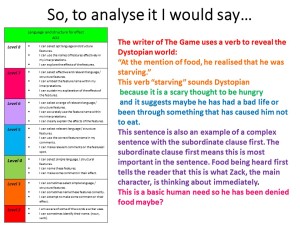I set myself a challenge this term to improve my teaching of grammar in order to help students develop their understanding and analysis skills.
I have found every year, by the time my students reached GCSE, they are struggling to identify the basic word classes like nouns and verbs when analysing writer’s craft. So, I set out to ensure that every other year group that got to their GCSE’s never found themselves in that position again.
Purchasing and reading a fantastic NATE book on grammar, I was inspired and decided to create a scheme of work, of 13 weeks, focusing on the theme of dystopia and the writer’s craft. The first half term I wanted students to recognise word class, sentence types and syntax and be able to explain the writer’s choices and the impact that it has. In the second half term, the students are to apply their understanding and learning and create their own dystopian world and emulate sophisticated writers studied in the previous half term.
I thought, as it has been such an epiphany for me, that i would share some of the things i have tried out successfully with my year 8.
I began with some calibration (Make it Stick by Peter Brown et al).

Students assessed how much they thought they knew in each area. Then i gave them the new KS2 grammar test. After marking it (student self marked) and dividing the scores between the different elements of grammar, the students were able to go back to this calibration sheet and compare the results – highlighting to themselves the importance of our grammar scheme to come.
I used the theme of dystopia and collected the opening chapters of dystopian stories from youth fiction like Gone to Orwell’s 1984.


We began with word classes; I asked students to note down all the word classes they knew first. Then in pairs I got them to play the matching game of these word classes. This was an activity i got them to play repeatedly as a starter over the next few lessons. Students were asked to try it first and checked their understanding and then I got them to play it against each other and the clock, turning the cards face down and mixing them up before continuing the activity.

The next step was being able to spot these purposeful choices of language. We read Gone and students identified the word classes specifically with regards to words that revealed the dystopian world of the story in order to begin linking to intention.
I ensured that my starter activities always built on and checked the learning and development of word classes (retrieval practice). Once students have secure knowledge of word classes we moved onto understanding the shifting of words amongst the classes – used ‘hand’ as an example and then asked students to find another in the extract from Gone we had been studying.

We developed word classes for another lesson by helping students understand how each word choice is specifically chosen for purpose. I modelled (rather precariously) one sentence from the story and then changing each word class until the whole sentence has a new meaning. Students then emulated this and looked at the meaning of their new sentence word by word.

The next week we moved onto a different dystopian story and focused on sentence types. I began by using common words from a fairytale asking students, in pairs, to recreate simple, compound and complex sentences in turn. This was the students calibrate activity as they had studied sentences in a previous scheme of learning.

Before accessing the second story i asked students to look at the opening to Philip Pullman’s Snow White (from the Grammar NATE book). Students looked at where the clauses were, what they told the students and then attempted to emulate this sentence for the opening of The Game (a prediction activity for the second dystopian story). I have posted on twitter some of the examples the students came up with – I was that proud of them!
These activities helped when we moved onto reading the story. I asked students to identify sentences that revealed the dystopian world along with the sentence type used. This helped students prepare themselves for the analysis.

I modelled the plan before also showing the step by step analysis of grammar. (above)
This was an opportunity for students to show that they could identify word class use and sentence type use along with analysing the choices made.
This was students F.A.I.L – first attempt in learning to help guide them for the S.A.I.L (second attempt in learning) and then their final T.A.I.L (third attempt in learning).
Before I allowed students to give it another go – I wanted to challenge them a little further and so, as our final story, we looked at 1984 and syntax choices, particularly the first two sentences.
I gave students the first sentence cut up and asked them to create a sentence using all the elements. We then identified the sentence type and the word classes choices. This was further developed when we looked at Orwell’s first draft in comparison. This enabled students to develop even further analysis of word choices and the impact it had on the reader. I have to say myself and the teaching assistant in the room at the time was blown away by what the year 8 students were coming up with.
Hopefully, when students are given their final analysis a go next week, students will be able to show their learning of accurate grammar elements learnt.
As a teacher, I feel that I’ve improved my teaching and understanding of grammar uses. Also I have really seen the impact of subject knowledge in this area – students are much more confident and sophisticated in their responses. It will definitely be something I will be bring into my teaching more often.





Hi, my faculty is also experiencing this problem and would like to implement something like this at KS3. The opening of the scheme looks wonderful. Do you have the full scheme available anywhere? Many thanks, Hannah
Hi,
I think it is a common problem at the moment. As I’m still working through the second half of my scheme, I don’t have a full ‘succinct’ final version yet. There are definitely adaptions and changes I want to make to improve as, unfortunately, I was in the position of creating this on the go and alone, which I find causes some holes in my scheme. I’ll be looking over it again during the summer. Thank you for your interest and comments.
I’d be interested to know how your department are tackling the issue.
Jemma
Hi,
Would it possible to know the name of the NATE Grammar book and to be able to access copies of your resources. They look great.
Hi,
this is the link to the book. It really is a useful read.
Thanks
Jemma